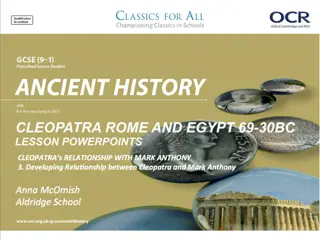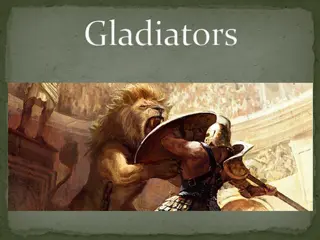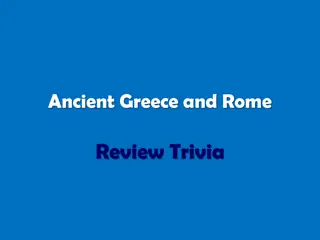Notable Emperors and Structures of Ancient Rome
Julius Caesar, Augustus Caesar, Hadrian, Marcus Aurelius, Diocletian, and Caligula were significant figures in ancient Rome, each with their own contributions and characteristics. From Julius Caesar's military prowess to Augustus Caesar's establishment of the Roman Empire, and Hadrian's emphasis on good governance and building projects, these emperors left a lasting impact on Roman history. Marcus Aurelius, known for his Stoic philosophy, and Diocletian, who divided the empire for better management, also played crucial roles. Caligula's reign was marked by initial benevolence followed by erratic behavior. The legacy of these emperors and their structures continues to be studied and admired.
Download Presentation

Please find below an Image/Link to download the presentation.
The content on the website is provided AS IS for your information and personal use only. It may not be sold, licensed, or shared on other websites without obtaining consent from the author. Download presentation by click this link. If you encounter any issues during the download, it is possible that the publisher has removed the file from their server.
E N D
Presentation Transcript
Emperors and Structures of Ancient Rome
Julius Caesar Expanded the Roman Republic through a series of battles across Europe before declaring himself dictator for life Devoted his energies to the conquest of Gaul (modern France) He died famously on the steps of the Senate at the hands of political rivals. Julius Caesar is often remembered as one of the greatest military minds in history and credited with laying the foundation for the Roman Empire.
Augustus Caesar As the first Roman emperor (though he never claimed the title for himself), Augustus led Rome s transformation from republic to empire following the assassination of his great-uncle and adoptive father Julius Caesar. He layed the foundations of the 200-year Pax Romana (Roman Peace) and an empire that lasted, in various forms, for nearly 1,500 years. Augustus Caesar died in A.D. 14, his empire secured and at peace. His reported last words were, I found Rome of clay; I leave it to you of marble.
Hadrian Viewed as the best of the good emperors . Worked hard to build a good government Issued a code of laws so that all were the same across the empire. Protected women, children, and slaves. Commissioned many building and other structures, including a great wall which parts still stand in Britain.
Marcus Aurelius Born on April 26, 121 Growing up, Aurelius was a dedicated student, learning Latin and Greek After his adoptive father died in 161, Aurelius rose to power and was officially then known as Marcus Aurelius Antoninus Augustus. His adopted brother served as his co-ruler Marcus Aurelius is also considered one of history's foremost stoic philosophers Was the last of the "Five Good Emperors
Diocletian He was perhaps both a good and bad emperor With the Roman Empire growing too large, he split the Roman Empire into two sections; the Eastern Roman Empire and the Western Roman Empire The split made Rome easier to manage and defend He also persecuted and killed many people, especially Christians, because of their religion
Caligula He started his rule well overturning many exiles, abolishing various taxes and gratified the people with spectacles and gifts After he had reigned for eight months he became severely ill. Upon his recovery his mind seemed to have been fatally damaged He became cruel and almost crazy (walked the streets dressed as various gods, made his horse a consul)
Nero The first five years of the reign of Nero were marked by the mildness and equity of his government. He discouraged luxury, reduced the taxes, and increased the authority of the Senate. He is usually referred to the cruelest of the Roman emperors The intentional burning of Rome is viewed as his worst crime. Rumor is he played musical instruments as it burned down. Nero did decide to blame the burning on the Christians, and inflicted upon them terrible cruelties and punishments
Constantine Tolerated all religions, but claimed that the Christian God helped him to obtain victory. Worked on strengthening the Christian religion and constructed important places of worship. Made Constantinople the capital of the Roman Empire.
The Colosseum Measuring some 620 by 513 feet (190 by 155 meters), the Colosseum was the largest amphitheater in the Roman world Inside, the Colosseum had seating for more than 50,000 spectators, who may have been arranged according to social ranking Hosted gladiatorial combats, hunts, wild animal fights and larger combats such as mock naval engagements (for which the arena was flooded with water) Colosseum video
Aqueducts The Romans constructed aqueducts to bring a constant flow of water from distant sources into cities and towns Aqueducts moved water through gravity alone, along a slight downward gradient within conduits of stone, brick or concrete. Aqueducts video























